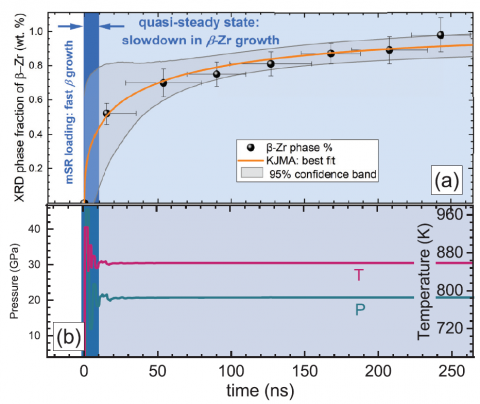HPCAT and DCS capabilities help to quantify the kinetics of a shock-driven phase transition in zirconium
One of the unanswered questions in physics is the time dependence of phase diagrams and how to model it. When a material is loaded dynamically through equilibrium phase boundaries, it is the kinetics that determines the real time expression of a phase transition. That in turn can play a significant role in the thermodynamic path that the material takes and its end state.
However, the role that kinetics of phase transitions play in a material’s constitutive properties is not well understood. This lack of understanding is due to a lack of experimental data of direct, atomic-scale in-situ measurements of kinetics of phase transitions during shock events.
In a recent work - which takes advantage of both DCS and HPCAT capabilities - a team of SNL scientists uses a combination of static and dynamic compression and x-ray diffraction (XRD) to study the kinetics of a shock driven phase transition in zirconium metal. They quantify the kinetics of formation of β-Zr phase at the atomic scale, by uniquely combining time-resolved synchrotron XRD with a multiple shock-and-release loading experiment. The SNL-led research project provides critical quantitative data that will allow to validate theoretical models of transition kinetics.
Such results are relevant not only to Zr, but also to other group 4 elements, and in particular to the behavior of Ti under high pressure. More broadly, access to data of kinetics of transformation shows the true time expression of a dynamically driven phase transition and highlights the time dependence of phase diagrams. Results are published in PRB Rapid Communications: P. Kalita, J. Brown et al., PRB Rapid Communications 102, 060101(R) (2020) https://doi.org/10.1103/PhysRevB.102.060101

